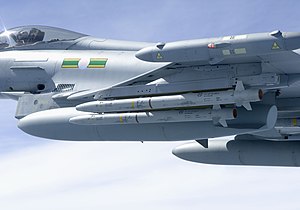ASRAAM
| Advanced Short Range Air-to-Air Missile | |
|---|---|

Two ASRAAM (centre) on a RAF Typhoon in 2007
|
|
| Type | Short-range air-to-air missile |
| Place of origin | United Kingdom |
| Service history | |
| In service | 1998 |
| Used by | RAAF , RAF, IAF |
| Production history | |
| Manufacturer | MBDA |
| Unit cost | >£200,000 |
| Variants | Common Anti-aircraft Modular Missile (Sea Ceptor) |
| Specifications | |
| Weight | 88 kg |
| Length | 2.90 m |
| Diameter | 166 mm (motor diameter) |
| Warhead | 10 kg blast/fragmentation |
|
Detonation
mechanism |
laser proximity fuze and impact |
|
|
|
| Engine | dual-burn, high-impulse solid rocket motor |
| Wingspan | 450 mm |
|
Operational
range |
300 m – 50 km (officially in excess of 25km) |
| Flight altitude | N/A |
| Speed | Mach 3+ |
|
Guidance
system |
infrared homing, 128×128 element focal plane array, with lock-on after launch (LOAL) and strapdown inertial guidance |
|
Launch
platform |
|
The Advanced Short Range Air-to-Air Missile, also known by its United States identifier AIM-132, is an imaging infrared homing ("heat seeking") air-to-air missile, produced by MBDA. It is currently in service in the Royal Air Force (RAF) and Royal Australian Air Force (RAAF), replacing the AIM-9 Sidewinder. ASRAAM is designed to outrange and outrun any other IR missile in service, allowing the pilot to fire and then turn away long before the opposing aircraft can close for a shot. It flies at well over Mach 3 to ranges as great as 50 kilometres (31 mi), well over double the range of earlier designs. It retains a 50g manoeuvrability provided by body lift technology coupled with tail control.
The project started as a British-German collaboration in the 1980s. It was part of a wider agreement in which the US would develop the AIM-120 AMRAAM for medium-range use, while the ASRAAM would replace the Sidewinder with a design that would cover the great range disparity between Sidewinder and AMRAAM. Germany left the programme after examining the latest Soviet designs of the 1980s, deciding that a missile with far greater short-range maneuverability was more important than range. The British proceeded on their own, and the missile was introduced into RAF service in 1998. It has since been selected to replace Sidewinder in the Royal Australian Air Force and is being introduced to the Indian Air Force. Parts of the missile have been used in the Common Anti-aircraft Modular Missile.
The first extensive use of IR missiles took place during the Vietnam War, where the results were dismal. The AIM-4 Falcon, the USAF's primary missile, scored hits only 9% of the time it was fired. The US Navy's AIM-9 Sidewinder fared only slightly better, achieving hits in 14 to 19% of firings, depending on the model. It became clear that the primary issue was that the pilots were firing as soon as the missile saw the target in the seeker, any time it was in front of the launch aircraft. However, the seekers had a very limited field of view so if the target aircraft was flying at right angles to the launcher, it would fly out of the seeker's view even as it left the launch rail.
...
Wikipedia
